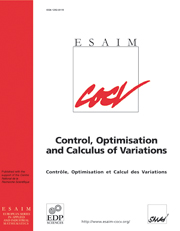Article contents
The steepest descent dynamical system with control. Applications to constrained minimization
Published online by Cambridge University Press: 15 March 2004
Abstract
Let H be a real Hilbert space, $\Phi_1: H\to \xR$ a
convex function of class ${\mathcal C}^1$
a
convex function of class ${\mathcal C}^1$ that we wish to minimize under the convex
constraint S.
A classical approach consists in following the trajectories of the generalized
steepest descent system (cf. Brézis [CITE]) applied
to the non-smooth function $\Phi_1+\delta_S$
that we wish to minimize under the convex
constraint S.
A classical approach consists in following the trajectories of the generalized
steepest descent system (cf. Brézis [CITE]) applied
to the non-smooth function $\Phi_1+\delta_S$ . Following Antipin [1], it is also possible to use a
continuous gradient-projection system.
We propose here an alternative method as follows:
given a smooth convex function $\Phi_0: H\to \xR$
. Following Antipin [1], it is also possible to use a
continuous gradient-projection system.
We propose here an alternative method as follows:
given a smooth convex function $\Phi_0: H\to \xR$ whose critical points coincide
with S
and a control parameter $\varepsilon:\xR_+\to \xR_+$
whose critical points coincide
with S
and a control parameter $\varepsilon:\xR_+\to \xR_+$ tending to zero,
we consider the “Steepest Descent and Control” system
\[(SDC) \qquad \dot{x}(t)+\nabla \Phi_0(x(t))+\varepsilon(t)\, \nabla \Phi_1(x(t))=0,\]
tending to zero,
we consider the “Steepest Descent and Control” system
\[(SDC) \qquad \dot{x}(t)+\nabla \Phi_0(x(t))+\varepsilon(t)\, \nabla \Phi_1(x(t))=0,\] where
the control ε satisfies $\int_0^{+\infty} \varepsilon(t)\, {\rm d}t =+\infty$
where
the control ε satisfies $\int_0^{+\infty} \varepsilon(t)\, {\rm d}t =+\infty$ . This last condition ensures that ε “slowly” tends
to 0. When H is finite dimensional, we then prove that
$d(x(t), {\rm argmin}\kern 0.12em_S \Phi_1) \to 0 \quad (t\to +\infty),$
. This last condition ensures that ε “slowly” tends
to 0. When H is finite dimensional, we then prove that
$d(x(t), {\rm argmin}\kern 0.12em_S \Phi_1) \to 0 \quad (t\to +\infty),$ and we give sufficient conditions under which $x(t) \to \bar{x}\in \,{\rm argmin}\kern 0.12em_S \Phi_1$
and we give sufficient conditions under which $x(t) \to \bar{x}\in \,{\rm argmin}\kern 0.12em_S \Phi_1$ .
We end the paper by numerical experiments allowing to compare
the (SDC) system with the other systems already mentioned.
.
We end the paper by numerical experiments allowing to compare
the (SDC) system with the other systems already mentioned.
Keywords
- Type
- Research Article
- Information
- ESAIM: Control, Optimisation and Calculus of Variations , Volume 10 , Issue 2 , April 2004 , pp. 243 - 258
- Copyright
- © EDP Sciences, SMAI, 2004
References
- 16
- Cited by




